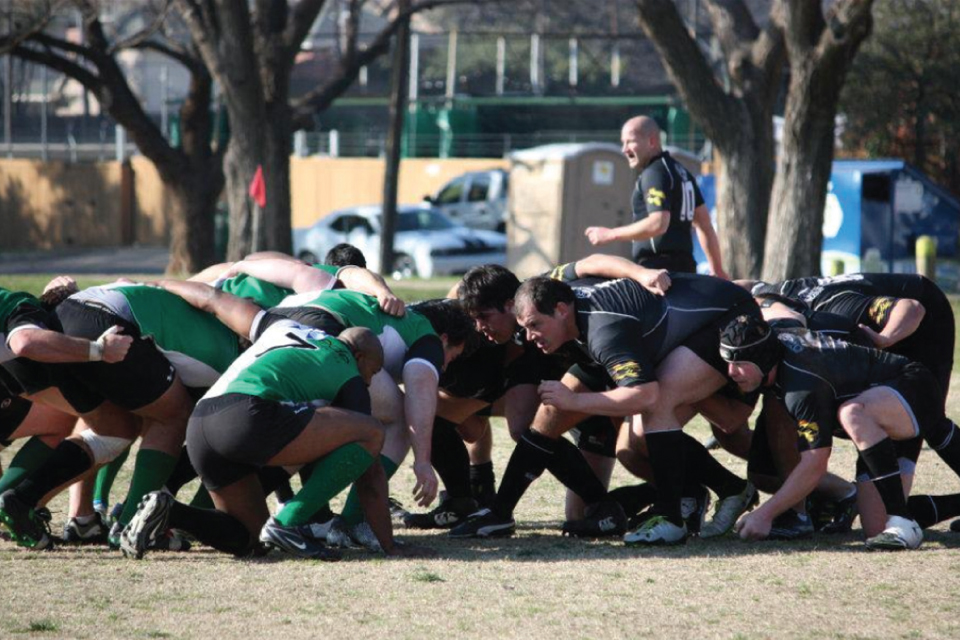An Introduction to the Rugby Union

Rugby, simply put, is one of the most brutal and physically demanding sports in the world. Think American football—with no helmets, pads, timeouts, or breaks between downs. The ball is in play for an average of 38 minutes compared to nine minutes in the NFL, and all 15 rugby players are expected to play offense and defense.
The match consists of two 40-minute halves, during which a player can expect to absorb nearly 300 impacts from unfriendly mini gorillas we like to call the opposition.
Rugby athletes will run more than six miles while changing speed and direction up to 750 times—roughly once every four seconds.
 During this 80-minute "workout," players will burn up to 2,000 calories, which is the equivalent of a 200-pound man running a half marathon (the difference being, no one is trying to knock the stuffing out of you by driving a shoulder into your exposed ribs during an afternoon jog).
During this 80-minute "workout," players will burn up to 2,000 calories, which is the equivalent of a 200-pound man running a half marathon (the difference being, no one is trying to knock the stuffing out of you by driving a shoulder into your exposed ribs during an afternoon jog).
A scrum (a form of restarting the game after an infringement) consists of two huddles, each made up of eight intricately linked men and weighing a total of some 2,000 pounds, each form-ing a single battering ram in an attempt to answer the age old question, “What happens when an unstoppable force meets an unmovable object?”
This brings us to the two most common questions any rugby player is asked when sitting in the pub telling war stories over a few beers:
Why the hell do you play that game—are you insane?
What do you do to prepare your body for that kind of punishment?
The first question is easy. You have to possess something a little wrong in your head to do this for fun. And I think most players would say they play for the challenge, the bond of brotherhood, and the social aspect that inevitably comes from sharing a drink with the guy who just tried to adjust your spine without attending chiropractic school.
The second question is a little more complex. Rugby places great strain on both your anaerobic and aerobic energy systems. The final 20 minutes of play typically features twice as many im-pacts (think tackles) and the most points scored. This means players have to be able to compete at a higher intensity level at the back end of the match.
Rugby players must possess speed, power, agility, and strength. They use intense amounts of energy with very little time to recover, which requires the use and constant changing between all three energy pathways (anaerobic, aerobic, and phosphagen).
 One in four rugby players will be injured during the season, with the majority of those injuries coming in the early part of the season, and that makes preseason training and conditioning in-credibly important.
One in four rugby players will be injured during the season, with the majority of those injuries coming in the early part of the season, and that makes preseason training and conditioning in-credibly important.
Preseason is an eight-to-12-week training block that the squad completes together. This is a mix of interval sprints, 1K shuttles, farklek running, long-distance runs, and CrossFit-style workouts. The aim of this is to increase cardiovascular output without sacrificing muscle mass, while work-ing across both anaerobic and aerobic energy systems.
In the weight room, rugby players like to lift heavy and favor big compound exercises such as dead lifts, clean and jerk, and squats. These movements require lots of muscle groups to work as one and also reinforce stabilizing muscles, which are important for injury prevention. These are complemented with explosive movements such as box jumps, Russian kettlebell swings, and plyometric ladders.
We are also seeing an increase in the use of yoga in our sport, again, to reduce the risk of injury through greater flexibility and the strengthening of core, postural, and intrinsic muscles.
The game of rugby is always evolving, and this is true of our training methodology. With little separating the top teams from the bottom, every team is looking for a physical edge and an ad-vantage through sports science.
Corcoran coaches the Austin Blacks, Austin’s rugby club. You can learn more about this championship team by reading “Austin Blacks Provide Top-Notch Rugby and a Truly Austin Experience” at austinfitmagazine.com, and you can check out their home games in March. They play the Dallas Reds on March 8, Fort Worth Rugby Club on March 15, and Houston Athletic Rugby Club (HARC) on March 22. Division I games are at 2 p.m. and Division II games are at 3:30 p.m., and all are played at Burr Field (6013 Loyola Lane, Austin, TX, 78723). For more info about the Austin Blacks, visit austinrugby.com






